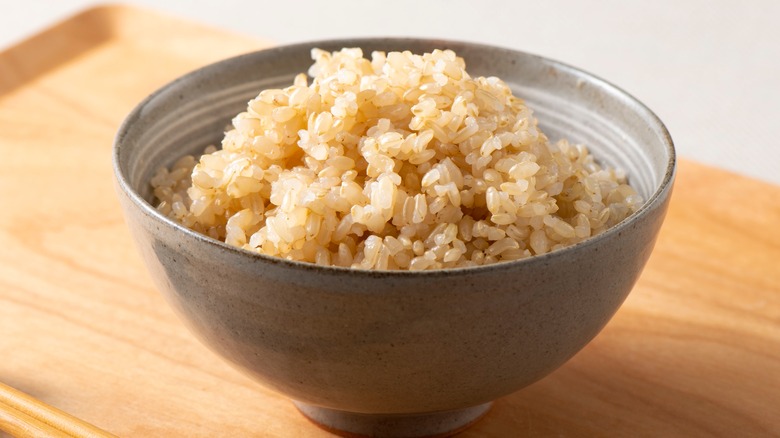The Cooking Assumption That's Ruining Your Brown Rice
Considering the fact that you could eat a different type of rice every day of the week and still not run out of a new one to try, it's really no surprise that rice is a dietary staple in many cultures. According to USA Rice, about 120,000 types of rice exist worldwide, differentiated by things like starch content, flavor profiles and aromas, size, and the degree to which each type is milled.
Still, rice is a simple grain and it really doesn't take rocket science to figure out how to cook it. Despite its simplicity, however, many struggle to get the most out of a particular rice's texture because the biggest mistake that people tend to make is to assume that all rice is cooked the same way. White rice is one of the most common varieties of rice and the ratio of water used to cook it is often the formula that's assumed for all types of rice. But when it comes to rice, one size does not fit all.
If you're cooking brown rice the way you would a batch of white rice and wondering why the grains are tough and coarse as opposed to chewy and tender, there's your problem: you're cooking brown rice as if it were white rice. Brown rice is very different from white rice and because of its makeup, it requires twice the amount of water and a considerably longer time to cook.
Brown rice has 3 layers
White and brown rice are two very different varieties and understanding what makes them different explains why they need to be cooked differently too. Rice has three layers: bran, endosperm, and germ. Bran gives the rice its fiber, the endosperm is the starch, and the innermost layer of germ is where the fats, proteins, and nutrients lay.
Brown rice is a whole grain which means that it retains all three layers that are present in the grain. This includes the endosperm, germ, and more importantly, bran. The fibrous coating of bran is what gives brown rice its chewy resistance and a more dense and hearty texture. It also slows the pace at which water enters the endosperm which means that it takes much longer to cook the grains through.
White rice, on the other hand, starts as brown rice but is milled until the germ and bran are gone, leaving only the starchy endosperm behind. This not only makes white rice more pliable to a tender texture with lesser water, but it's also what makes white rice much quicker to cook and a little less nutritious in comparison. A 100-gram serving of cooked white rice — or almost a half cup — for example, has 0.4 grams of fiber as compared to brown rice which packs in 1.6 grams, per Healthline. Considering the stark difference in their makeup, it's really no surprise if the assumption that brown and white rice cook the same way is ruining your fluffy grains.
Give brown rice more time to cook
It's clear that brown rice requires a slightly different approach than white rice so the question is, how exactly should you cook it? While the ratio for white rice varies from one and a half to two cups of water for every cup of grains, 2:1 is a good ratio to follow for brown rice. As a general rule of thumb, use twice the amount of water to the amount of brown rice.
Another thing to note is that it's going to take a little longer to cook brown rice through. The starchy makeup of white rice means that it generally cooks in 15 minutes on a stove and fluffs up after it is set aside to rest for another five. Brown rice needs more than double that time and takes 45 to 50 minutes to cook and another 10 off the heat to soak up the extra water and tenderize.
Brown rice can also be cooked in an Instant Pot using a 1:1 ratio of water to rice on high pressure and it'll come together in 15 minutes. Alternatively, if all the proportions of water are too much to remember, A Couple Cooks says that you can always cook brown rice using the pasta method, in which you cook the rice the way you would pasta – boil it uncovered in plenty of water for about 20 minutes, then drain the excess water, put the rice back in the pot, cover, and steam for another five minutes. They say it "cooks perfectly every time."



